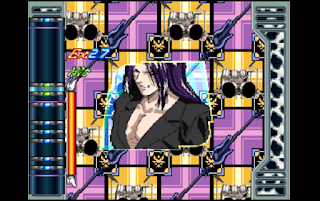In 2006, Nintendo released a strange samurai-themed voice-controlled pinball/strategy game called Odama. Unfortunately, I haven't yet been able to play Odama, but it was in my mind the whole time I was playing San Goku Shi Pinball. It doesn't have any voice controls, and it's setting is the Romance of the Three Kingdoms, rather than feudal Japan, but still: olden times battlefield pinball. I doubt it was made as a deliberate mockbuster anyway, coming out six year later than Odama, and Odama not being the kind of massive hit you'd bother mockbusting anyway.
That doesn't mean it's just a generic pinball game with a Three Kingdoms coat of paint, though. Instead, you go through various differnt stages, each followed by a boss. The stages are all different, though they all consist of a small battlefield area, littered with soldiers, battlements, and so on. The goal in the stages is to defeat all of the enemy officers who are commanding the endlessly respawning troops, while also lighting torches and finding hidden treasures and bonus stages to score more points.
The boss fights are slightly different, and all take place in a little castle courtyard area. in that courtyard, there'll be a prominent figure from the Romance of the Three Kingdoms, and you have to defeat them by repeadly hitting them with the ball (the one exception to this that I've ecountered was Zhang Jiao, who is defeated by extinguishing his magic purple bonfires dotted around the place. Bosses can fight back by attacking your flippers and disabling them for a couple of seconds, which is something I always hate. Taking away the player's input just seems like a cheap copout form of difficulty.
San Goku Shi Pinball isn't one of the greatest pinball games you'll ever seen, and it has some stiff competition on the 3DS in the form of Pinball Hall of Fame, which contains recreations of Taxi, Pinbot, and a bunch of other real-life tables. But those are recreations of real tables, and San Goku Shi is a whole new pinball videogame with all the advantages and possibilities that brings. So it's fine. If you already have Pinball Hall of Fame, and want more, less realistic pinball on your 3DS, then you wouldn't be too disappointed if you went with this one.




















